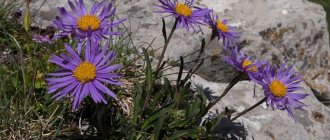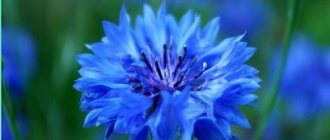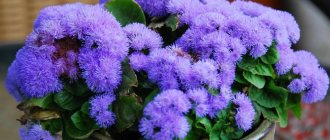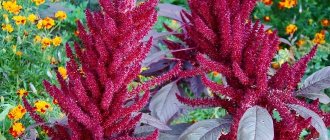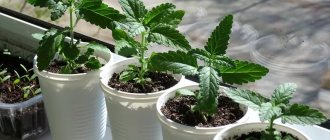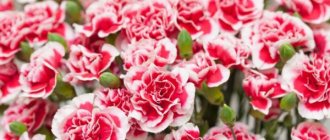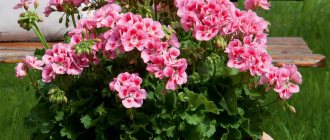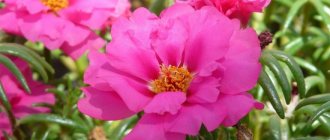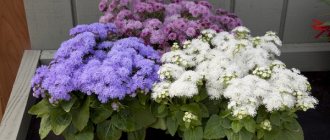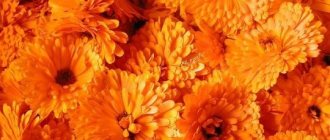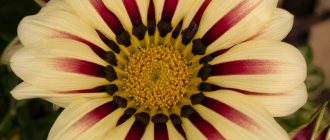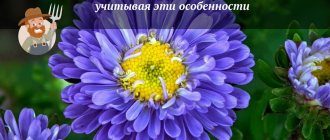Planting and caring for perennial alpine astramits requires classical knowledge of this genus, which has about 250 different varieties. In their natural habitat, perennials are widespread throughout the northern hemisphere. Plants are perfectly adapted to harsh living conditions. The culture is frost-, cold-, and stress-resistant and easily tolerates drought. Thanks to their unique qualities, alpine ground cover perennial asters are very popular among landscape designers.
Alpine aster is a unique stress-resistant ornamental plant cultivated by humans since the mid-16th century.
Description and characteristics
An amazing flower - the alpine aster is able to bloom in the same place for about 7 years without interruption. The period of intensive budding occurs in 3-4 years. The plant is characterized by the following external signs:
- stems are strong, erect, pubescent;
- stem height up to 40-50 cm;
- leaves are spatulate, ovate or lanceolate (depending on the variety), pubescent;
- inflorescences - single baskets with reed petals;
- diameter of inflorescences from 3 to 8 cm;
- the color of the inflorescences is various shades of white, red, blue, pink, blue, violet.
Every year, the root system of a perennial crop spreads a certain distance along a horizontal plane.
The photo shows an alpine perennial aster that can delight with the abundant flowering of chamomile-like inflorescences from May to September.
Alpine aster is a unique stress-resistant ornamental plant cultivated by humans since the mid-16th century.
Features of aster
Aster is a rhizomatous plant with simple leaf blades. Basket-inflorescences are part of corymbose or paniculate inflorescences. The baskets consist of marginal reed flowers of various colors, as well as central tubular flowers, which are very small and most often yellow. In European countries, aster cultivation began in the 17th century, and thanks to the tireless work of breeders, many incredibly beautiful varieties have appeared, and among them there are plants with flowers of various shapes and colors. As a rule, the seed method is used to propagate such a plant. Depending on the height of the shoots and the quality of the baskets, such flowers are used for group plantings, borders, rockeries, ridges, or as decoration for terraces and balconies. Asters make spectacular bouquets, and cut flowers can last quite a long time.
Annual asters - growing from sowing to flowering
Varieties of alpine perennial aster
One of the most popular herbaceous plants for open ground is the alpine aster. Various varieties are popular among landscape designers, florists and gardeners. Each of them is naturally endowed with original external parameters.
Different varieties of alpine perennial asters differ not only in their color diversity, but also in the shape of their inflorescences
Stained glass
The Vitrazh variety belongs to cold-resistant and frost-resistant crops. The height of the bushes is up to 50 cm. The leaves do not die off in the winter. Inflorescences are in the form of snow-white baskets of a single type, up to 5 cm in diameter.
Stained glass is used to form borders, the front line of mixborders, alpine slides
White Alps
The perennial alpine aster White Alps is characterized by a bush height of up to 30 cm. White chamomile-shaped flowers with yellow centers attract with abundant flowering from July to September.
The compact variety White Alps fits harmoniously into flowerbeds, mixborders, alpine slides, and is used for cutting
Blue
The large-flowered alpine perennial aster Blue (Blue) has a stem height of up to 50 cm. The flowering of numerous inflorescences is impressive with a blue-blue hue. The diameter of the Blue inflorescences is 6-8 cm. Each bush of the Blue Alpine aster is a separate bouquet, a complete composition.
The long-blooming variety of perennial aster Blue is one of the most popular and unpretentious varieties for border decoration.
Pink
Alpine Pink Aster is a stunning, popular ground cover variety that blooms early. The variety looks good in the foreground in prefabricated seasonal mixborders, complex figures with periodic color changes. The color of the inflorescences is pink, the diameter is up to 4 cm, the height of the bush is 25-30 cm.
Read more Sowing aster in open ground in spring: when to sow, care, photo
The flowering of the Pink Alpine star lasts from May to July; with the timely removal of faded inflorescences, the flowering period of the crop can be extended
Happy End variety
The winter-hardy variety of perennial aster Happy End is characterized by a height of up to 25-30 cm. The flowers are dark pink with a purple tint, a yellow center, and up to 4 mm in diameter. Happy End blooms in May-June.
Happy End asters are perfect for landscaping lawns, flower beds, mixed borders, borders
Illyria
Alpine aster Illyria compares favorably with other perennials with a diverse palette of shades of white, lilac, and blue. The height of the bushes is up to 20 cm, the diameter of the inflorescences is up to 5 cm.
The plant is used to decorate rocky alpine hills and multi-colored borders
Alpine blend
Perennial aster Alpine mixture is a popular and sought-after variety. The height of the stems is up to 30 cm, the diameter of chamomile inflorescences is up to 4 cm.
The culture is used for cutting, design of prefabricated flower beds
Sabina
The perennial Sabina belongs to the terry alpine varieties. The diameter of the original double purple inflorescences is up to 4 cm. The height of the Sabine bush is up to 20 cm.
The terry perennial aster Sabina looks original on alpine hills, in the foreground of flower beds
Description of the species and its origin
Asters are unique flowers, because they can grow even in the most unfavorable regions, bloom the longest, and there is a very wide variety of them. Moreover, each flower and variety is like a separate, unique natural masterpiece. Asters amaze with their variety of shades, including burgundy, purple, lavender and rare blue. Seeds can be bought everywhere.
Alpine aster is one of the main species; by the name you can understand where this species comes from. Yes, in the wild, such flowers prefer to grow in mountainous regions, on hillsides. Moreover, if you haven’t understood yet, then this is a species, and it already includes many different varieties for every taste. What is so special about these flowers? For example, the timing of flowering.
Asters can bloom early, in summer and autumn, along with chrysanthemums. It’s not so often that you see flowers in the garden that are already pleasing in May, and these are not primroses. It is the Alpine aster that can bloom in the spring. To do this, it is planted using the seedling method. But you can sow the seeds directly into the soil, which gives another great advantage to asters. Yes, they are rarely afraid of return frosts and grow quite quickly, the main thing is to choose a good place and soil. But more on that later.
Alpine aster is a perennial; it can grow in one place for more than one year, but to keep the bush beautiful, it is better to renew it and replant it every 3-4 years. This flower belongs to the large family of Asteraceae. The root system is well developed, it is located parallel to the ground. It begins its growth with a rosette of leaves, which, as the stem grows, become smaller and smaller towards its end; here a bud begins to form. The flowers are located in baskets, where there can be up to 25-30 of them.
On a note! Many people confuse asters with simple daisies, chrysanthemums and daisies. But still, these are different flowers with their own requirements for soil and care. Primary colors are white, pink, lilac, crimson, blue.
The height of the bushes is up to 35 cm, there are also shorter representatives of the species - up to 15-20 cm, which makes them an ideal decoration for borders, alpine slides, and paths. Flowers look great in flowerbed arrangements or simply planted in rows. You can even create a design using different colors of alpine stunted asters.
When to plant alpine aster
The most popular method of propagating perennials is by seeds. Alpine aster is grown from seeds using seedlings and non-seedling methods (sowing in open ground).
Alpine aster seeds are sown for seedlings at the end of February or early March. Alpine aster seedlings are transferred to open ground at the end of May or early June after a consistently warm average daily temperature has been established.
In the southern regions, seeds are sown in open ground at the beginning of May or at the end of November before winter.
Plants grown from seeds sown in open ground begin to bloom within a year
Growing from seeds
Alpine aster seeds ripen in late July or early August. They are flattened, obovate-shaped achenes with a small white “tuft.” When sown directly in the ground, seeds rarely germinate normally, especially when it comes to early flowering varieties. In the conditions of the cold Russian spring, it is difficult to obtain well-warmed soil, so seed germination deteriorates. First, the seeds are sown at home, then the grown plants are transplanted into open ground.
In order for seeds to germinate successfully at home, it is recommended to adhere to the following rules:
- For sowing, prepare small boxes filled with nutrient substrate.
- Seeds are sown in moist soil, and the ambient temperature should be at least +20° C.
- Boxes with sown seeds are covered with glass or film.
- When seedlings appear, the temperature in the room is lowered by two degrees, or the boxes are moved to a cooler place.
- When 3-4 leaves appear on the sprouts, they are dropped into separate peat cups.
- At the beginning of May, the plants are taken out to the balcony or outside during the daytime so that the asters get used to the street conditions.
- When warm weather sets in, the plants are planted in open ground.
- Choose a sunny place for planting.
- The soil in the area where the aster will be planted must be fertile. What plants need most is calcium.
- The flower does not like high humidity, so the area should not be too low and water should not stagnate on it.
- Asters can grow in one place for up to five years. Then the bushes are divided, discarding the old ones, and transferred to other areas.
If you come across a variety that you want to have in your garden plot, but there is no way to collect seeds, you can propagate the flower using apical cuttings. Its length should be at least 6 cm. After cutting, the cuttings are planted in the shade in moist, fertilized soil and covered with a glass jar or a cut plastic bottle. Within a month the plant will take root.
You can also propagate your favorite alpine beauty by dividing adult bushes.
Sowing seeds and caring for seedlings
Experienced gardeners distinguish two main methods for sowing seedlings of perennial alpine aster:
- classical sowing by deepening seeds treated with growth stimulants and disinfecting solutions;
- special sowing of alpine aster seeds in boiling water.
Growing alpine aster seedlings is a painstaking process, since the seed material does not have a high degree of germination.
Growing aster seedlings at home allows you to get beautifully flowering plants for decorating your local area.
Preparing containers and soil for growing seedlings
As a planting container, choose any container with sufficient drainage from broken bricks or expanded clay.
The soil should be loose and nutritious. This could be a universal mixture:
- garden soil;
- sand;
- peat;
- humus.
The soil is spilled with a solution of potassium permanganate for disinfection.
The seeds of perennial alpine asters have poor germination, so they are prepared for planting with growth stimulants and disinfected in a solution of potassium permanganate.
To prevent infection of seedlings with fungal infections, seeds of perennial alpine asters are treated with a 1.5% solution of potassium permanganate
Classic method of sowing seedlings
When sowing classically in containers, furrows are made up to 1-1.5 cm deep. The seeds are buried in the prepared soil mixture. Planting pattern:
- distance between rows - up to 8 cm;
- the distance between the seeds is up to 5 cm.
Read more Planting aster for seedlings: when and how to sow correctly, photo
The seeds are sprinkled with earth on top, and the container with the seeds is covered with plastic film or glass to create a greenhouse effect.
Comfortable microclimate for crops - sufficient level of illumination and air temperature not lower than +20⁰С
Special method of sowing seedlings
A special method for obtaining seedlings is to treat the crops with boiling water. As with classical planting, the prepared seeds are placed in a container with soil mixture, following the universal scheme. After distributing the planting material on the soil surface, the crops are spilled with boiling water, the container is covered with glass or film to ensure a greenhouse effect.
Seedling care
The container with the crops is placed in a warm place, on the south, well-lit side at room temperature not lower than +18-20⁰С. Watering is done as needed. After the emergence of seedlings, the shelter is removed and the temperature is lowered to +16-18⁰С. When 3-4 main leaves are formed, the seedlings are picked. The sprouts of perennial asters are hardened off 2 weeks before transplanting into open ground.
The seedlings should be watered in a timely manner, avoiding the formation of a crust on the soil surface.
Alpine asters - sowing dates, step-by-step agricultural technology, growing methods
When to sow aster?
There are several options - in the spring for seedlings at home, outside - closer to summer, or in the fall - before winter. If you want to grow seedlings so that they bloom in May, then start sowing from the second ten days of March until the beginning of April. If there is no time and place to do such plantings, then you can sow the seeds in May, but the asters will bloom only in the summer. There is also an option to make furrows after frosts - by sowing aster in this way, you will get seedlings in the spring. Weather hardening will allow the seedlings to be strong and grow quickly.
Important! Plant every year according to the dates of the gardener’s lunar calendar. This assistant talks about any issues on the site with flowers, vegetables, and trees.
We sow perennial aster using the seedless method
You took into account all the nuances and found the place. Now you need to pour boiling water over it to disinfect it and add humus. This is done approximately 1-2 weeks before the intended sowing. If your soil can hold moisture, add some sand or perlite to the furrows or holes. Now sow the seeds to a depth of 3 cm. Then sprinkle with soil, water and place a sign so as not to trample the crops.
If you want to sow alpine aster seeds in winter, then do all the same steps after the first frost. Then plant the seeds and mark the location. If your region has very harsh winters, then the crops can be mulched until spring with straw, spruce branches or peat. After germination, the mulch will need to be removed. It will retain both warmth and moisture for future flowers.
We sow alpine aster for seedlings
We choose a date according to the lunar calendar. By this day, you should already have prepared the soil and containers for sowing. You can buy soil or mix your own - turf soil, humus - in equal parts, 1/2 part sand, a spoonful of ash and a teaspoon of superphosphate. Any soil must be spilled with boiling water. Then make holes at the bottom of the trays, lay out a layer of drainage, and fill with soil.
Sow in furrows two centimeters deep. Moisten with warm water from a spray bottle and cover with film until germination. We place the seedlings on the window, when four leaves appear, we pick them into separate cups. It is better to take pots from peat or simple cardboard so that they can be immediately planted in the ground in May.
Advice! Until the alpine aster seedlings have sprouted, the temperature in the room should be 20-23 degrees, but after germination it is better to keep the seedlings at 16-18 degrees so that they harden.
Alpine aster care
So, your seedlings grow and develop, and in May you plant them in a permanent place, which must be prepared in advance, as described above. Or your asters sprouted immediately into the soil after sowing. After two weeks, you can add a complex preparation with a high content of phosphorus and potassium to the soil. Next, you need to feed the asters every 2-3 weeks so that they can bloom luxuriantly. You can use Agricola and Kemira-Lux.
Water the flower bed when the soil is almost dry. If there is stagnation, the roots will begin to rot, the flowers will wither or bloom less frequently. After each watering, you need to loosen the beds, thereby allowing the soil to breathe, weeding the beds from weeds. Asters are watered and replanted in the evening.
Every three years, it is better to divide the bushes and replant them, so that the rhizome and ground part will be renewed. You can propagate alpine aster by seeds, then do not remove those flowers that have bloomed, but collect them in the fall after they have completely dried. It is also possible to propagate aster by cuttings - cut off the top shoots 20 cm long, soak them in Kornevin and plant them in moist soil. On top you need to place a shelter from a transparent plastic bottle, which must be opened slightly every day to give the seedlings oxygen. The cuttings will take root in about a month.
Planting in open ground
Alpine aster seedlings are planted in open ground at the end of May or at the beginning of June when stable air and soil temperatures have been established during the day.
Since asters are light-loving crops, when choosing a place to place seedlings, it is necessary to give preference to open, well-lit areas without drafts.
The soil is dug up, fed with superphosphate and dolomite flour, peat, sand and humus are added.
Seedlings are placed in shallow holes along with a ball of earth, following the planting pattern:
- distance between bushes - up to 20 cm;
- the distance between rows is up to 40 cm.
After the seedlings are buried, grooves are made between the rows for watering
Rules for planting aster
Planting must be carried out in accordance with certain requirements. Gardeners advise planting in early May. The soil should be slightly moist. The interval between sprouts should be fifteen to twenty centimeters. Three days after planting, the first watering is required. After seven days, fertilize with mullein solution. It is better to carry out work in the evening. It is good to conduct them in cloudy weather. If the sun is shining, the seedlings should be covered for a certain period until they take root.
Recommendations for plant care
Professional gardeners explain that planting and caring for heather aster is a simple procedure. You should follow simple rules, which will ensure decorativeness and good flowering of plants. Watering should be regular but moderate. Water is taken that has settled. During the dry period, it is necessary to provide abundant watering, but it is better to stick to the golden mean so as not to overdo it with watering. In this case, it is necessary to prevent water from getting on the leaves of the heather aster.
In order for the aster to delight with abundant flowering, it must be fertilized at least three times per season. To do this, use complete mineral or organic fertilizers. Adding ash to the soil gives good results. This helps to reduce the acidity of the soil and enrich it with potassium.
It is recommended to periodically loosen the trunk circles of the New England aster to provide the rhizomes with the necessary oxygen. But loosening should be superficial, to a depth of no more than six cm. This is explained by the superficial root system. In conditions of insufficient air exchange and nutrients, disease is inevitable. They can be caused by fungi.
Weeds and fading inflorescences should be removed promptly. Since the crop can withstand frost, it is not covered for the winter, but only the above-ground part is cut off, leaving 20-30 cm above the ground. When the plant reaches a height of fifty to seventy-five centimeters, a support should be installed. It will provide support to the plant during the growth process. You can prevent diseases and stimulate abundant flowering by planting asters every 2-3 years. The best period will be April. If the heather aster was not pruned for wintering, then the dried shoots are removed in early spring.
Pests of heather aster
Periodically, shrubs need to be inspected for timely detection of diseases. In dry weather, the crop is threatened by spider mites, which can be controlled with an acaricide or an infusion of onion peels. The danger is represented by a nematode that causes brown spots to appear. Damaged leaves are removed manually. If this does not help, then the entire bush should be removed.
Powdery mildew in the form of a white coating can damage plantings. This is especially true in rainy weather. To combat this disease, fungicides of synthetic origin are used, as well as products containing copper. The most effective drugs are Topaz, Skor, etc. For preventive measures, copper sulfate or Bordeaux mixture is used.
Fusarium wilt can lead to the death of the bush. There are currently no effective drugs for it. The plant is removed and then burned. The danger threatens plants on loamy acidic soil at high daytime temperatures. You can fight the meadow bug with the help of such means as Aktara, Decis. The insecticide needs to be changed periodically so as not to cause the pests to become addicted.
Growing and care in open ground
The perennial alpine aster is an unpretentious ornamental plant that requires minimal care in the open ground:
- moderate watering without waterlogging with soft, settled water;
- hilling bushes to strengthen the root system;
- loosening the soil to prevent the formation of a crust on the surface of the earth;
- mulching with pine needles or sawdust to block weed growth and retain moisture;
- fertilizing with potassium and phosphorus fertilizers in early spring after transplanting seedlings into open ground, mullein solution in June, wood ash in autumn;
- removal of weeds to prevent infection by fungal diseases and pests;
- removing faded inflorescences to ensure an aesthetic appearance;
- preparing for winter, trimming dried leaves and stems to the root collar, covering with dry leaves.
removing faded flowers stimulates the formation of new buds
Alpine aster. Planting and care. Reproduction
The world of flora never ceases to amaze and fascinate with its splendor. A separate group of universal perennials allows you to create flower beds that are stunning in their beauty and uniqueness. Alpine aster, blue alpine daisy, mountain aster - this is all the name of one species of the Asteraceae family, perfect for creating a rock garden.
The basket-shaped flowers of cultivated garden species are particularly decorative; they are larger, 3-6 cm in diameter and can be white, purple or pink in color with a yellow, terry center formed from many small tubular petals.
Alpine aster. Features of planting and care
Despite the fact that alpine aster is quite unpretentious, to obtain the most decorative color effect and beautiful shape of the bushes, well-drained soil is required, without special requirements for acidity. Fertilized, carefully dug loamy soil with a high calcium content will guarantee more decorative, abundant and long-lasting flowering. Light soils require regular moisture, otherwise, with prolonged drought, plants may stop flowering and lose their decorative appeal.
To obtain a good exposure, planting must be organized so that the flower garden is located on a bright, but slightly protected from direct sunlight, area oriented to the south, east or west. Species of alpine asters with an autumn flowering period must be placed in more sunny places, since in the shade they may not have time to bloom.
In order for varieties intended for autumn flowering to form buds in the same year, their planting must be organized in the spring, at a distance of 20-45 cm, after which the plantings must be thoroughly watered and constantly monitor the soil, which is always must be wet. Young shoots should not be allowed to become exposed and, if necessary, problem areas should be covered with a small, 2-3 cm layer of specially prepared soil.
It is not necessary to introduce fertilizing in the year of planting, as this can stimulate excessive leaf growth, which will negatively affect flowering. Lack of moisture during the period of bud formation can lead to premature yellowing of leaves, a decrease in the number of blossoming inflorescences, or, in general, stop the flowering process. To maintain a good aesthetic appearance, the bushes should not be allowed to grow and thicken greatly. After 3-4 years they need to be divided and transplanted to another place. In some cases, it is allowed to stay in one area, without transplanting, for 5-6 years.
Reproduction - which method is better
Propagating alpine aster by sowing seeds directly into open ground is a troublesome and unjustifiable method due to the low germination of seeds, the inability to create an optimal temperature in nature for friendly shoots, and the long waiting period from sowing to the flowering period.
The best results can be achieved by sowing seeds at the end of March or, in extreme cases, the beginning of April, in special seedling boxes or greenhouses adapted for early planting, since the seeds germinate only at a temperature not lower than +20 degrees. During the growing period, it is necessary to maintain the temperature within 15 - 18 degrees Celsius. Higher air temperatures can cause seedlings to stretch, weaken and be susceptible to disease.
After the formation of 2-3 full-fledged leaves, it is necessary to make a dive and already in May, when the soil warms up to the desired temperature and stable warm weather sets in, you can plant it in a permanent place prepared for placing a flower garden.
The method of vegetative propagation by dividing the bush is considered more acceptable and is more often used in practice than growing seedlings by sowing seeds. There is no need to dig up the entire bush; using a sharp shovel, it is enough to divide the rhizome into parts, so that on each there are several shoots left.
The distance between plantings depends on the condition of the separated part. Strong and powerful plants should be placed according to the 50x80 pattern, while weaker plants should be placed in 20x30 cm.
There is another method that is used mainly when propagating varietal alpine asters. Tops - 5-8 cm cuttings are taken from large healthy plants, planted in a darkened area in a substrate consisting of peat, rotted turf soil and sand, in proportions 1: 2: 1. Propagation by cuttings can be carried out during all warm months, starting from May and including mid-August. After 30 days, when the root system is formed, the plants can be transplanted to a permanent location.
| Have you already thought about installing an alpine slide on your site? Surely you have been haunted by questions: Where is the best place to place an alpine slide? What stones are suitable for an alpine slide? Which plants are suitable for an alpine slide, and which ones should not be used? Answers here: | |
Alpine aster. Care and protection from diseases
Timely pruning of old and damaged branches, preventing the formation of thickened and unventilated bushes, as well as maintaining optimal humidity, will protect the flower from damage by gray mold.
Good bottom ventilation, timely removal of fallen leaves, reducing humidity at the first signs of disease and treatment with special compounds will protect the plants and maintain a healthy aesthetic appearance.
There is no need to leave a heavily damaged plant on the site, as this may contribute to the spread of the disease throughout the entire area. It is very important to promptly remove and burn flowers infected with gray mold. Alpine aster is perfect for rock gardens and will fit perfectly into a rock garden that allows for a freer choice of plants. By placing this type of aster in a mixborder or in the foreground of a flowerbed, you will be able to admire not only the flowers, but also a large number of butterflies that love to visit areas where alpine flowers bloom.
Reproduction methods
There are several ways to propagate the alpine perennial aster:
- seed (seedlings and non-seedlings);
- vegetative (by dividing the bush and cuttings).
Read more How to treat asters from diseases and pests
Dividing the bush can be done throughout the summer season. Experienced gardeners recommend dividing the root system and replanting the mother bush at least once every 7 years.
Transplanting plants when dividing a bush stimulates flowering and improves the decorative properties of the crop
Dividing the bush
When dividing the bush, the mother plant is completely dug out of the ground, all dry, rotten stems, roots, and shoots are removed. The sections are treated with wood ash. The plots are planted in new places, in prepared and fertilized soil.
The aster can be planted in its original place after 5 years
Cuttings
Cuttings of alpine perennial asters are carried out in the spring. The apical branches with three viable leaves are cut from strong shoots. The cuttings are kept in root formation stimulants and planted in the prepared soil mixture:
- sand;
- peat;
- turf land.
The cuttings are covered with film, periodically ventilated and watered. They are transplanted to a permanent place in open ground in September.
Cuttings allow you to completely preserve varietal characteristics
Reproduction
The following methods of propagation of alpine asters are distinguished:
- seeds;
- dividing the bush;
- cuttings.
Planting material for seed propagation is collected in November, when flowering ends. The collected seeds are planted in a fertilized substrate and covered with film or glass for better germination of seedlings. In mid-March and early April, when the seedlings form the first 2-3 leaves, they are picked and planted in separate containers.
Asters bloom with this method of reproduction only in the second year. This method is not particularly popular because it is labor intensive and ineffective - seed germination is very low.
You can learn more about propagating alpine aster by seeds from the video below:
Most often, perennial alpine asters are propagated by dividing the bush into several parts. The best time for this procedure is late spring or early autumn. The division is made with a disinfected, sharply sharpened knife.
The resulting divisions are planted at a distance of 15-20 cm from each other. When the seedlings grow up, they can be transplanted to a permanent place.
Another method of propagating alpine asters is cuttings, in which the mother bush is completely duplicated.
Important! With this propagation method, it is recommended to take cuttings only from strong, healthy plants.
The cut cuttings are cleared of leaves in the area of the lower internode and treated with any growth stimulant or succinic acid. The upper end of the trim is pinched.
The cuttings take root in 12-15 days. In order for the plants to take root better in the nursery, the cuttings are covered with plastic film or glass to create greenhouse conditions. To prevent the planting material from rotting out, the shelter must be raised daily for about 10 minutes. Watering is done as the soil dries.
In September, asters are planted in a permanent place.
When do alpine aster seedlings bloom?
Alpine aster seedlings produce flower stalks the following year after rooting in open ground. If it produces buds in the fall of the year the seedlings are planted, they should be cut off. Young plants that bloom in autumn may not survive winter well.
Most varieties of alpine perennial aster are characterized by a flowering period of May-July
Description of the plant
Autumn perennial aster is a representative of the perennial Asteraceae family. It differs from other varieties in the appearance of ovoid basal leaves, as well as the presence of a petiole. The leaves are similar to those of other species, but they are much smaller in size. The height of the shrub aster reaches 35 cm. The root system is located horizontally relative to the ground surface and branches very well.
The stems and leaves of the plant have a noticeable bluish pubescence. When in bloom, alpine white or pink aster can be confused with the humble alpine daisies or daisies. Inside the inflorescence there are tubular yellow flowers. The number of reed flowers that make up the inflorescence-baskets varies from 26 to 65 pieces.
When asters bloom, there is a delightful smell all around. The color of the flowers can be reddish, blue, white, purple, crimson, terracotta, pink, brick.
Cultivated “Alpines” have a diameter of 3 to 7 cm. The hemispherical involucre has 2-3 rows of oblong lanceolate-shaped leaves. The obovate achenes ripen in August. The flowering time of this elegant plant is on average 3–4 weeks.
The habitat of wild plants is widespread high in the mountains. The homeland is the Alps, where the aster got its name. It also grows in the Carpathians, the Caucasus and on the slopes of the Sayan Mountains. These modest plants are very unpretentious and do not require much attention from gardeners. But in order to reveal all the beauty and power of the alpine aster, flower growers recommend the following growing conditions.
Mountain plants love well-lit places, so they need to be planted in sunny areas with minimal shading during the day. The site must have good drainage and water should not stagnate to avoid rotting of the rhizome. An excellent soil option for alpines is loam and alumina. Before planting, you should add lime or dolomite flour to the soil, since this type of plant really needs calcium. Very poor soil should be fertilized with humus.
These flowers grow well in areas that were previously occupied by other plants, such as calendula or marigolds. The growth time of perennial aster in one area should not exceed 5 years.
Diseases and pests
Perennial asters are susceptible to infection by fungal pathogens: powdery mildew, fusarium, and blackleg. Diseases affect the root system, stems, foliage, and inflorescences.
When the first signs of disease are detected, the affected plants should be treated with solutions of modern fungicides (Topaz, Fitosporin)
Young shoots and leaves, unopened buds of asters are attacked by slugs, aphids, spider mites, cutworms if proper care is not taken. Modern insecticides (Karbofos, Actellik) help get rid of pests for a long time.
Timely removal of weeds allows you to resist attacks from parasitic insects
Caring for a garden aster
Aster is an unpretentious plant, so growing it in your garden is quite simple. The most important thing to remember is to loosen the soil surface in a timely manner, while removing all weeds. It is necessary to loosen the surface of the soil near the bushes every time watering is carried out or it rains, and the depth of loosening should not exceed 40–60 mm. Even before the bushes begin to branch, they should be hilled to a height of 60 to 80 mm, in which case their root system will develop much faster.
Watering
Aster is one of those plants that react extremely negatively to both dry soil and stagnation of liquid in it. During a long dry and hot period, watering should become more rare, but plentiful (about 30 liters of water per 1 square meter of land); after this procedure, it is necessary to loosen the soil surface. If the soil dries out, this may cause the inflorescences to become less spectacular.
Top dressing
In order for the bushes to be powerful and as decorative as possible, they will need systematic feeding. During one season, such flowers need to be fed at least three times:
- first feeding - 7-15 days after transplanting into the garden, for this, 10 grams of potassium sulfate, 20 grams of ammonium nitrate and 50 grams of superphosphate are added per 1 square meter of plot;
- the second - at the beginning of budding, for this purpose 50 grams of superphosphate and the same amount of potassium sulfate are added to the soil per 1 square meter;
- third - as soon as flowering begins, the same fertilizers are used for this as for the second feeding.
Do not forget to promptly remove inflorescences that have begun to fade.
Possible problems
As a rule, inexperienced gardeners may have problems growing asters in their garden plot. For example:
- After sowing, the seedlings do not appear, or they appear, but grow very slowly and dry out . In this case, experts advise reseeding, while strictly following all agrotechnical rules. Particular attention should be paid to the composition of the substrate, as well as to the pre-sowing preparation of the seed.
- Annuals are affected by fusarium . Remember that areas where representatives of the Solanaceae family (tomatoes, potatoes) or flower crops such as carnations, tulips, gladioli and gillyflowers were previously grown are not suitable for planting such flowers. These areas can be used for growing asters only after at least 5 years, as the likelihood that they will be affected by fusarium increases. For the same reasons, fresh manure is not used to feed bushes.
- The formed inflorescences are incomplete . This can happen due to the fact that spider mites or aphids have settled on the bushes, they feel a lack of nutrients, or due to non-compliance with the agrotechnical rules of the crop.
Diseases of asters
Fusarium
Most often, this crop is affected by fusarium. The causative agent of this disease is fungi of the genus Fusarium. Symptoms of damage appear in an adult bush, so it suddenly begins to wither, and only on one side, after which it begins to turn yellow, brown and wither. To date, experts have not found an effective method of combating fusarium; therefore, it is extremely important to follow preventive measures, namely, follow the rules of crop rotation and crop rotation on the site. In one area, aster should be planted alternately with other crops, and it can be replanted there no sooner than after 5 years. All affected bushes are dug up and destroyed immediately after their discovery, this will help prevent the spread of the disease.
Blackleg
Asters can also be affected by another fungal disease called “black leg”. As a rule, bushes are affected by it during the seedling period, the diseased plant darkens, and its root collar and base of the stem begin to rot. The development of the causative agent of this disease is observed in acidic soils. All affected bushes must be pulled out and destroyed, the soil mixture is spilled with a solution of potassium permanganate (1%), and the surface of the substrate around the seedlings is sprinkled with a layer of sand.
Rust
Such flowers can also be affected by rust, with swellings forming on the underside of the leaf blades, which contain spores. The foliage on the affected bushes begins to wither and dry out. The area where asters grow should be as far as possible from coniferous plants, since most often it is from them that rust spores fall onto the bushes. For preventive purposes, treat the plants with a solution of Bordeaux mixture (1%), and diseased bushes should be treated with the same product once every 7 days.
Jaundice of asters
This plant can also be affected by a viral disease called aster jaundice. It is caused by a virus carried by leafhoppers or aphids. At the very beginning, the color of the foliage becomes lighter, and then general chlorosis of the leaf blades sets in, and the bush begins to grow more slowly. The buds also develop poorly, which also turn pale green. In order to prevent the bushes from being affected by the disease, it is necessary to combat its carriers; for this, the bushes are treated with a solution of an insecticidal preparation, for example: Pirimor, Actellik or Pyrethrum. At the same time, diseased bushes are dug up and destroyed.
Bushes affected by verticillium or powdery mildew are recommended to be treated with Fundazol.
Why do asters dry up? Diseases of asters
Pests of asters
Aster can be harmed by insects such as the meadow bug, slobbering pennies, arable slug, common earwig, spider mite, bud aphid and cutworm. In order to protect such flowers, you need to adhere to a number of preventive measures:
- in the fall it is necessary to carry out deep digging of the site;
- the area is cleared of the remains of annual plants and stems of perennials, which die off by autumn, and it is recommended to destroy them;
- choose the right varieties of flower crops for your garden plot;
- if necessary, improve the soil by adding compost and humus or liming;
- Keep the recommended distance between the bushes, otherwise they will be elongated and weakened.
If you do notice harmful insects on flowers, then get ready to fight them either with chemicals or folk methods. To destroy arable slugs, you can use Metaldehyde or collect it by hand and then destroy it. Treatment with Fundazol will help in the fight against the common earwig. To get rid of cutworms, meadow bugs, slobbering pennies and spider mites, you need to use a solution of Phosfamide, Karbofos or Pyrethrum.
ASTER DIES FROM DISEASES AND PESTS
Application in landscape design
Perennial alpine asters are a magnificent decoration of the local area, park and garden areas. Plants are harmoniously combined and coexist with various ornamental crops:
- with non-flowering or inexpressively flowering ground cover plants (stachys, sedum);
- with flowering crops of different flowering periods (daffodils, tulips, chrysanthemums, marigolds, geraniums);
- low-growing varieties are especially relevant at different elevation levels of alpine hills;
- close plantings of alpine varieties of varying heights look beautiful next to phlox, daylilies, astilbe in original mixborders;
- in ridges along houses and various architectural forms;
- for decorating borders.
Chrysanthemums are excellent “neighbors” for perennial asters; in July they pick up the “relay” of flowering
Types and varieties of asters with photos and names
Relative of asters
Not every gardener will be able to figure out whether an aster is in front of him or not. The fact is that there is a genus of asters, which is represented by perennial and annual species and varieties, which were discussed above. And there is also the so-called garden aster, which inexperienced gardeners mistake for an annual aster, but it is just a close relative of this plant. It would be more correct to call the annual aster Callistephus - this is a monotypic genus of flowering plants, native to China, it belongs to the Asteraceae or Asteraceae family. Callistephus is represented by annuals and biennials; gardeners call this plant “garden aster” or “Chinese aster”. A description of this single species of the genus was given by Carl Linnaeus in 1825, and he called it Aster chinensis. A. Cassini later separated it into a separate genus and gave it the name Callistephus chinensis, or Chinese callistemma. Simple or branched shoots are colored green, less often - dark red. The fibrous root system is well branched and quite powerful. Alternate leaf blades have petioles. The inflorescences are represented by baskets, and the fruit of such a flower is an achene. There are approximately 4 thousand varieties of this plant in cultivation, all of them are divided into approximately 40 groups. Most often, this particular plant is cultivated by gardeners and is mistaken for an annual aster.
Early flowering perennial asters
Perennial asters are divided into a couple of groups according to their flowering time, namely: autumn-blooming and early-blooming. There are not very many early-flowering asters, and this group includes only the following species: Alpine aster (Aster alpinus), Bessarabian aster (Aster bessarabicus) and Italian aster (Aster amellus).
alpine aster
Such perennials, blooming in May, can reach a height of 15–30 centimeters. The diameter of single baskets reaches 50 mm; in appearance they are similar to simple daisies. They are often used for rockeries. The best varieties:
- Glory - a bush reaches a height of about 25 centimeters, the diameter of the inflorescence is up to 40 mm, a bluish-blue chamomile with a bright yellow center;
- Wargrave - the height of the bush is about 0.3 m; in May-June it is decorated with pink inflorescences with a yellow center, which reach 40 mm in diameter.
Italian aster or chamomile
Flowering occurs in June–July. The height of the plant is about 0.7 m, large inflorescences-corythes reach up to 50 mm in diameter. These flowers are suitable for rockeries and rocky gardens. The best varieties:
- Rosea - the color of the tubular flowers is brownish, and the reed flowers are pink, flowering begins in June and lasts about 3 months;
- Rudolf Goeth - large scutes reach 40–50 mm in diameter, their tubular flowers are yellow, and their reed flowers are purple.
Aster Bessarabian, or false Italian
The height of the bush is about 0.75 m, it is decorated with a large number of lilac flowers with a pale brown center.
Autumn-blooming perennial asters
Autumn-blooming perennial asters include bush aster, New Belgian aster and New England aster.
Bush aster (Aster dumosus)
These are the earliest of the autumn-blooming asters. This plant is native to North America. The height of the bush can vary from 0.2 to 0.6 m. The shoots are heavily leafy, so even when the bushes are not blooming, they still look impressive and are very similar to boxwood bushes. The best varieties:
- Niobe and Alba flora Plena - the color of the inflorescences is white;
- Blue Bird - the height of a dwarf plant is about 0.25 m, the inflorescences are pale blue, like the taller Blue Bouquet and Lady in Blue.
New Belgian aster (Aster novi-belgii), or Virginian aster
This plant is widespread in mid-latitude gardens. There are vigorous varieties, the height of which is about 1.4 m, as well as dwarf varieties - bushes no higher than 0.3–0.4 m. Powerful bushes are decorated with paniculate inflorescences. Flowers can be colored white, blue and purple, as well as various shades of burgundy and pink. The best varieties:
- Snowsprite - the height of a dwarf variety is about 0.35 m, the color of the inflorescences is white;
- Jenny - the height of a dwarf bush is about 0.3 m, it is decorated with red flowers;
- Audrey is also a dwarf variety, about 0.45 m high, with pink inflorescences;
- Royal Velvet - the height of a medium-sized bush is about 0.6 m, the color of the flowers is violet-blue;
- Winston S. Churchill - medium-growing variety, about 0.7–0.75 m high, bright ruby flowers;
- Dusty rose - the height of a vigorous bush is about 100 cm, light crimson inflorescences reach about 40 mm in diameter;
- Desert Blue - this vigorous variety can also reach a height of about one meter, the diameter of the inflorescences is about 35 mm, and their color is bluish-lilac.
Characteristics of the variety
The species was cultivated in the 16th century. It unites a group of herbaceous perennial ground cover plants. The rhizome of the alpine aster is branched and horizontal. The shoots do not exceed 30 cm in height. The branches below are covered with oblong leaves with slight pubescence, on top they are linear, small, sessile. The bushes reach 50 cm in diameter. Sprawling, the aster covers the ground with a colorful carpet, decorating it, preventing the growth of weeds and the evaporation of moisture. The flowering period of the mountain aster depends on the climate and variety.
Spring varieties bloom from May to June, summer varieties bloom in July and August. Autumn varieties bloom in the fall. Their flowering can last from the first days of September to the end of October.
The perennial inflorescences are single baskets. The color of the marginal flowers is reed-shaped, delicate, pastel. They can be pale or bright lilac, pure white, lilac, blue or violet.
In the middle there are tubular bright yellow flowers. The size of the inflorescences is 4-5 cm in diameter. In appearance, they resemble daisies. July and August are the period of seed ripening. The bushes greet the winter green.
The most popular varieties
To decorate the site, mainly low-growing varieties are used, with spreading bushes and abundant flowering in the first half of summer.
Alpine aster Pink
Early flowering species: pink buds up to 4 centimeters in diameter appear in May. The bush produces abundant growth, occupying an area of up to half a meter. The height of the stems does not exceed 30-35 centimeters.
Blue
Above the spreading green cushion of rosette leaves rises 10-15 centimeters, a bush dotted with violet-blue flowers, 6 centimeters in size.
Aster perennial mixture
The name aster means that the spreading bush will enliven the landscape with bright, semi-double multi-colored buds.
White Alps
Low bushes, showered with buds, with a basket of yellow tubular flowers, surrounded by two-row, narrow white petals.
Albus
Snow-white flowers with a yellow eye resemble chamomile. The height of the stem does not exceed 20 centimeters.
Illyria
Flower baskets resemble a daisy in shape. Buds of different shades bloom on one bush.
Astra Blue
A powerful bush rises above the soil up to 50 centimeters. The petals are blue, the core is yellow. The corolla can reach 8 centimeters in diameter. The plant prefers to grow in partial shade.
Superbus
The variety is low-growing, with abundant flowering of small lilac buds with a blue tint.
Ruber
Alpine aster grows up to 40 centimeters. The color scheme of the basket is yellow-raspberry.
Goliath
Over time, each bush grows to the size of a flower bed with a carpet of lilac buds.
Constant pruning is required to maintain its shape.
Happy end
In landscape design, low bushes with soft pink flowers are used to create borders. Early variety: buds appear in early May.
See also
Care and propagation of garden hibiscus, rules for planting and growing
Read
Botanical description of alpine aster
The ornamental plant is a ground cover plant, which explains its widespread use in landscape designs. Favorable climatic conditions for growth are the cool latitudes of Northwestern Europe, North America, and the Caucasus Mountains.
Alpine aster is a perennial, the period of active growth and flowering is 7 years. The number of subspecies is more than 200.
General signs:
- the height of the stems varies from 10 to 40 centimeters;
- grows as a bush;
- number of flowers on 1 bush – from 7 to 50 units;
- the structure, size, shape of the leaf changes vertically;
- flower basket - 2 or 3 rows;
- flower diameter – 5-6 centimeters;
- petal colors - blue, purple, red, pink, white;
- the core is yellow tubular flowers.
Flowering time depends on the variety: May-September. The plant tolerates low temperatures and lack of moisture well, does not require special care, and reproduces easily.
